
- Saint of the Day

Saint Martin of Tours
- November 11
- Franciscan Media
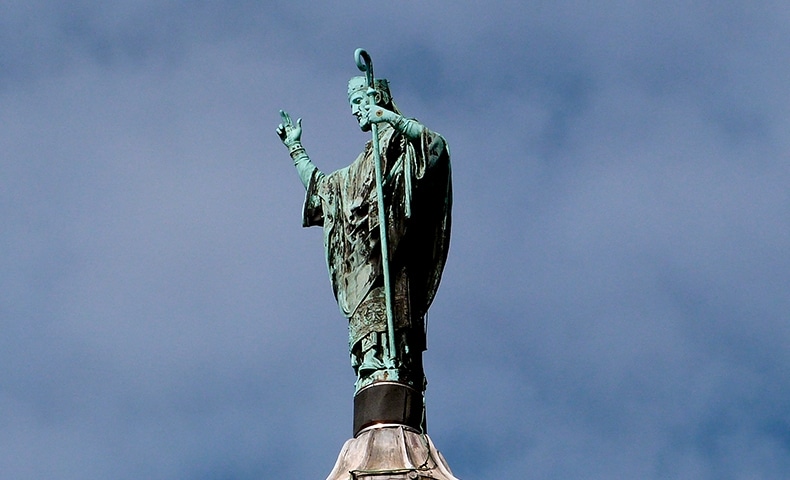
Image: Statue of Saint Martin of Tours on the dome of the Basilica of Saint Martin of Tours | photo by ZohaStel
Saint of the day for november 11, (c. 316 – november 8, 397).
Saint Martin of Tours’ Story
A conscientious objector who wanted to be a monk; a monk who was maneuvered into being a bishop; a bishop who fought paganism as well as pleaded for mercy to heretics—such was Martin of Tours, one of the most popular of saints and one of the first not to be a martyr.
Born of pagan parents in what is now Hungary, and raised in Italy, this son of a veteran was forced at the age of 15 to serve in the army. Martin became a Christian catechumen and was baptized when he was 18. It was said that he lived more like a monk than a soldier. At 23, he refused a war bonus and told his commander: “I have served you as a soldier; now let me serve Christ. Give the bounty to those who are going to fight. But I am a soldier of Christ and it is not lawful for me to fight.” After great difficulties, he was discharged and went to be a disciple of Hilary of Poitiers.
He was ordained an exorcist and worked with great zeal against the Arians. Martin became a monk, living first at Milan and later on a small island. When Hilary was restored to his see following his exile, Martin returned to France and established what may have been the first French monastery near Poitiers. He lived there for 10 years, forming his disciples and preaching throughout the countryside.
The people of Tours demanded that he become their bishop. Martin was drawn to that city by a ruse—the need of a sick person—and was brought to the church, where he reluctantly allowed himself to be consecrated bishop. Some of the consecrating bishops thought his rumpled appearance and unkempt hair indicated that he was not dignified enough for the office.
Along with Saint Ambrose, Martin rejected Bishop Ithacius’s principle of putting heretics to death—as well as the intrusion of the emperor into such matters. He prevailed upon the emperor to spare the life of the heretic Priscillian. For his efforts, Martin was accused of the same heresy, and Priscillian was executed after all. Martin then pleaded for a cessation of the persecution of Priscillian’s followers in Spain. He still felt he could cooperate with Ithacius in other areas, but afterwards his conscience troubled him about this decision.
As death approached, Martin’s followers begged him not to leave them. He prayed, “Lord, if your people still need me, I do not refuse the work. Your will be done.”
Martin’s worry about cooperation with evil reminds us that almost nothing is either all black or all white. The saints are not creatures of another world: They face the same perplexing decisions that we do. Any decision of conscience always involves some risk. If we choose to go north, we may never know what would have happened had we gone east, west, or south. A hyper-cautious withdrawal from all perplexing situations is not the virtue of prudence; it is in fact, a bad decision, for “not to decide is to decide.”
Saint Martin of Tours is a Patron Saint of:
Horses Soldiers South Africa

Sign Up for Our Daily Newsletter
Includes Saint of the Day, Minute Meditations, and Pause + Pray.

We are Franciscan Media, a sponsored ministry of the Franciscan Friars of Our Lady of Guadalupe Province. We strive to inspire a loving world that embraces the Franciscan spirit of harmony, joy, and simplicity. May our resources renew your spirit as we share God’s love in the spirit of St. Francis.
Recent Articles
A prayer for those i do not know, hearts moved to praise, related and connected, a surge of green, padre pio and the madonna, 28 w. liberty st. cincinnati, oh 45202.
513-241-5615 [email protected]
Customer Service: [email protected]
Technical Questions: [email protected]
Writer’s Guidelines Privacy Policy Post a Prayer Request Donor Portal
- Asia - Pacific
- Middle East - Africa
- Apologetics
- Benedict XVI
- Catholic Links
- Church Fathers
- Life & Family
- Liturgical Calendar
- Pope Francis
- CNA Newsletter
- Editors Service About Us Advertise Privacy

St. Martin of Tours Feast day: Nov 11
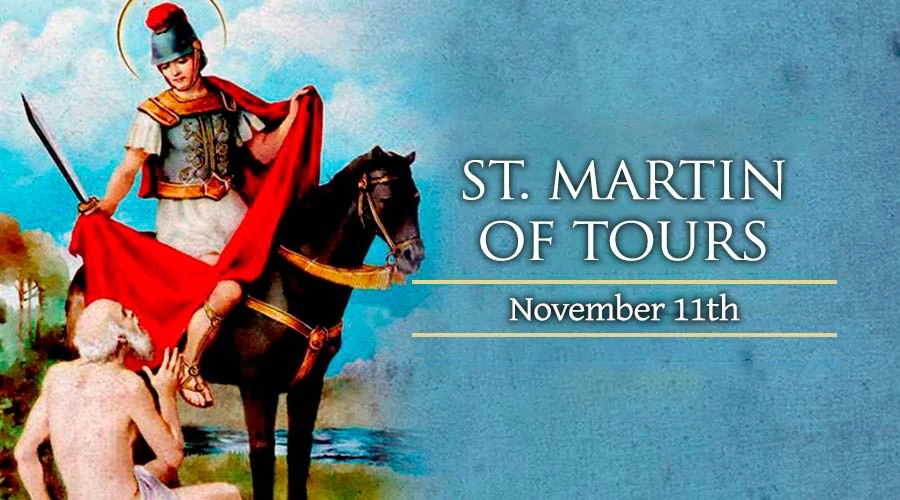
On Nov. 11, the Catholic Church honors St. Martin of Tours, who left his post in the Roman army to become a “soldier of Christ” as a monk and later bishop.
Martin was born around the year 316 in modern-day Hungary. His family left that region for Italy when his father, a military official of the Roman Empire, had to transfer there. Martin's parents were pagans, but he felt an attraction to the Catholic faith which had become legal throughout the empire in 313. He received religious instruction at age 10, and even considered becoming a hermit in the desert.
Circumstances, however, forced him to join the Roman army at age 15, when he had not even received baptism. Martin strove to live a humble and upright life in the military, giving away much of his pay to the poor. His generosity led to a life-changing incident, when he encountered a man freezing without warm clothing near a gate at the city of Amiens in Gaul.
As his fellow soldiers passed by the man, Martin stopped and cut his own cloak into two halves with his sword, giving one half to the freezing beggar. That night, the unbaptized soldier saw Christ in a dream, wearing the half-cloak he had given to the poor man. Jesus declared: “Martin, a catechumen, has clothed me with this garment.”
Martin knew that the time for him to join the Church had arrived. He remained in the army for two years after his baptism, but desired to give his life to God more fully that the profession would allow. But when he finally asked for permission to leave the Roman army, during an invasion by the Germans, Martin was accused of cowardice.
He responded by offering to stand before the enemy forces unarmed. “In the name of the Lord Jesus, and protected not by a helmet and buckler, but by the sign of the cross, I will thrust myself into the thickest squadrons of the enemy without fear.” But this display of faith became unnecessary when the Germans sought peace instead, and Martin received his discharge.
After living as a Catholic for some time, Martin traveled to meet Bishop Hilary of Poitiers, a skilled theologian and later canonized saint. Martin's dedication to the faith impressed the bishop, who asked the former soldier to return to his diocese after he had undertaken a journey back to Hungary to visit his parents. While there, Martin persuaded his mother, though not his father, to join the Church.
In the meantime, however, Hilary had provoked the anger of the Arians, a group that denied Jesus was God. This resulted in the bishop's banishment, so that Martin could not return to his diocese as intended. Instead Martin spent some time living a life of severe asceticism, which almost resulted in his death. The two met up again in 360, when Hilary's banishment from Poitiers ended.
After their reunion Hilary granted Martin a piece of land to build what may have been the first monastery in the region of Gaul. During the resulting decade as a monk, Martin became renowned for raising two people from the dead through his prayers. This evidence of his holiness led to his appointment as the third Bishop of Tours in the middle of present-day France.
Martin had not wanted to become a bishop, and had actually been tricked into leaving his monastery in the first place by those who wanted him the lead the local church. Once appointed, he continued to live as a monk, dressing plainly and owning no personal possessions. In this same spirit of sacrifice, he traveled throughout his diocese, from which he is said to have driven out pagan practices.
Both the Church and the Roman Empire passed through a time of upheaval during Martin's time as bishop. Priscillianism, a heresy involving salvation through a system of secret knowledge, caused such serious problems in Spain and Gaul that civil authorities sentenced the heretics to death. But Martin, along with the Pope and St. Ambrose of Milan, opposed this death sentence for the Priscillianists.
Even in old age, Martin continued to live an austere life focused on the care of souls. His disciple and biographer, St. Sulpicius Severus, noted that the bishop helped all people with their moral, intellectual and spiritual problems. He also helped many laypersons discover their calling to the consecrated life of poverty, chastity and obedience.
Martin foresaw his own death and told his disciples of it. But when his last illness came upon him during a pastoral journey, the bishop felt uncertain about leaving his people.
“Lord, if I am still necessary to thy people, I refuse no labour. Thy holy will be done,” he prayed. He developed a fever, but did not sleep, passing his last several nights in the presence of God in prayer.
“Allow me, my brethren, to look rather towards heaven than upon the earth, that my soul may be directed to take its flight to the Lord to whom it is going,” he told his followers, shortly before he died in November of 397.
St. Martin of Tours has historically been among the most beloved saints in the history of Europe. In a 2007 Angelus address, Pope Benedict XVI expressed his hope “that all Christians may be like St Martin, generous witnesses of the Gospel of love and tireless builders of jointly responsible sharing.”
Latest news

Florida Supreme Court approves 15-week pro-life law, allows abortion amendment on ballot

Thousands mourn slain NYPD officer at Catholic funeral
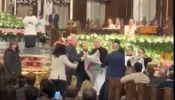
Pro-Palestinian protesters disrupt Easter Vigil Mass at St. Patrick’s Cathedral in NYC

As wife joins the Catholic Church, Jordan Peterson says Easter is ‘the core story of humanity’
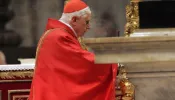
Pope Francis: I was ‘used’ against Ratzinger in 2005 conclave, but he was ‘my candidate’
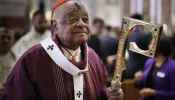
Washington archbishop: Biden ‘picks and chooses’ parts of Catholic faith

Pope Francis: The resurrection of Jesus changes our lives completely and forever

Catholic cemeteries on the front line against secular fear of death
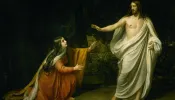
Why the Catholic Church celebrates Easter Monday under the title ‘Monday of the Angel’
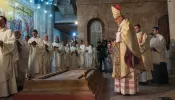
‘The mother of all holy vigils’: Jerusalem basilica is first place to announce Easter

Life of St. Martin of Tours
St. martin of tours.
Both Saint Martin and Saint Nicholas are remembered for their heroic charity, both became famed wonder-working bishops, and both saved sailors from shipwreck. As we celebrate the feast day of Martin, November 11, we focus here on this saint whose fabled life notably started with the pity he showed a poor beggar by cutting his cloak in two, making him in one stroke the patron of both soldiers and tailors!
A Military Man
Born into a pagan military family around 316, Martin’s father was a tribune, subject to constant reassignment. Martin was born in modern day Hungary but grew up in Pavia, Italy, where his father was stationed. In those formative years he was attracted to Christianity. At age ten he went to church and begged to become a catechumen. At age twelve he wanted to become a hermit. But at fifteen, he was drafted into the Roman army due to a law issued by the emperor demanding that sons of retired veterans should take their fathers’ places. Soon he was stationed in Reims and later in Amiens, where the signature event in his life occurred. As he was passing through the city gates one bitterly cold winter, he spied a forlorn and tattered beggar pleading for alms. Having nothing to give him but a share in his own clothing, Martin drew his sword and cut his cloak in two. In a painting by an unknown German master the beggar is depicted as a crippled invalid missing a foot. This is common to German illustrations of the legend, and it contrasts strikingly with Martin, who is depicted standing in bright red leggings rather than in his usual pose, armored and riding a horse. Here the enabled one extends charity to the disabled and a Gospel mandate is fulfilled: “I was naked and you clothed me…inasmuch as you did it to the least of my brethren you did it to me” (cf. Mt 25:36, 40). That night in a dream, Martin saw Christ wearing that portion of cloak that he had given the beggar, and heard him saying to the angels that surrounded him, “Martin the catechumen has clothed me with this garment.” Thereupon Martin had himself baptized. More than ever he wanted to renounce the world and live entirely for Christ, but he lived up to his military contract for two more years, envisioning himself more and more as a soldier for Christ rather than for the emperor.
After his release from the army, Martin presented himself to Hilary, the bishop of Poitiers, who made him an acolyte. In a dream he was told to visit his parents and convert them. His mother embraced the faith, but his father would not. On this journey, he preached against the Arian heresy, and suffered a public scourging for it when he fell into the hands of the enemy. Managing to return to Poitiers, the bishop gave him a plot of land on which to build a hut. It was two miles outside the city in a place now called Ligugé. This became the core of Martin’s spirituality: prayer, solitude, and sacrifice. Adopting a hair shirt and animal skins for his habit (a far cry from the fancy uniform depicted in the painting) Martin lived the life of a hermit in his wooden hut. In time, he attracted more and more men who wanted to follow his example. From this primitive beginning, Martin established the first monastic community in Gaul. The discipline he received in the military provided the fertile ground in which his monastic system could flower. But the Lord had further plans for Martin, and called him from his spiritual oasis when the bishop of Tours died in 371.
A Beloved Bishop
Martin had no desire to become a bishop (the first sign that he would make a good one). But supporters tricked him into coming to Tours, where he was persuaded to stay and assume the episcopacy. He did not occupy the bishop’s residence and he refused to sit on the bishop’s throne. He sat on a three-legged stool instead. He also abhorred the tumult of the city, and established another monastery as his home, this time in a series of caves carved out of the cliffs of nearby Marmoutier. As many as eighty men joined him, and from among this ascetic group many cities chose their bishops.
As bishop of Tours, Martin preached around the countryside, performing many wonders, from communication with animals to raisings from the dead. Nearly a thousand years before Saint Francis, Martin was known to kiss a poor leper and cure him. The saint’s biographer, Sulpicius Severus, compared Martin to the Apostles, and attributed to him amazing miracles that included healings, exorcisms, visions of angels, and temptations by devils. In 397, as he saw death approaching, he donned sackcloth and ashes. When he finally expired, those around him heard choirs of angels singing. The people of both Poitiers and Tours fought over his body. Saint Ambrose of Milan claimed to have telepathically attended his funeral. Later, the kings of France would carry Martin’s cloak into battle as a talisman for victory. But the triumph worth winning, as Martin’s life attested, was in the victory over self and the allurements of the world. And this insight came from a man who was a bishop, who remained a monk, who remained a soldier for Christ to the end.
Both Saint Martin and Saint Nicholas are remembered for their heroic charity, both became famed wonder-working bishops, and both saved sailors from shipwreck. As we celebrate the feast day of Martin, November 11, we focus here on this saint whose fabled life notably started with the pity he showed a poor beggar by cutting his cloak in two, making him in one stroke the patron of both soldiers and tailors!
7963 S. 116th Street Franklin, WI
414-425-1114, [email protected].
WeConnect | By LPi
The Complete Pilgrim - Religious Travel Sites
Howard Kramer's, The Complete Pilgrim, Religious Travel Site
BASILICA OF ST. MARTIN OF TOURS
February 15, 2015 By Howard Kramer Leave a Comment
Tours, France
The current Basilica of St. Martin of Tours is, depending on how you count, at least the sixth church built over the tomb of this popular French saint. Martin, along with his contemporary Hilary of Poitiers, was instrumental in the establishment of Christianity in Western Europe, as well as halting the spread of Arianism. The current incarnation of this church honoring St. Martin was constructed in the late 19th and early 20th centuries, making it one of the youngest major Catholic pilgrimage shrines in Europe. The Basilica’s predecessors were traditionally part of the Routes of Santiago de Compostela, though the current church is not included as part of the UNESCO site.
Martin of Tours was a contemporary and acquaintance of the other great French saint of the period, Hilary of Tours. While Hilary was perhaps more important from a historical perspective, Martin was undoubtedly the more colorful of the two. Born in Hungary into a family of Roman aristocrats, his father was a cavalry officer, and Martin was brought up to follow in his footsteps. It is likely that he saw service in battle against the various Germanic tribes that were then harassing Roman territories in Western Europe.
According to tradition, Martin was leading a force near modern-day Amiens in France, when he shared some clothing with a beggar. He subsequently had a vision of Christ, who recognized Martin’s generosity even though he was at the time still a pagan. He was baptized shortly thereafter, became a pacifist, left the army and became a faithful Christian. He served as a disciple of Hilary in Poitiers, eventually became bishop of Tours, founded a monastery there, and became one of the most important champions against heresy in the history of France.
Hilary was the dominant Christian figure in Gaul in the second half of the 4th century, a crucial time when Germanic barbarians were threatening the western frontiers of the empire. Because of his military service and his ability to rally people under the Christian banner, Martin is often recognized as a protector of France. After his death, his gravesite in Tours became a pilgrimage destination. An early chapel was constructed there in the early 5th century.
Because of its popularity, the first chapel was replaced with a larger basilica around 470. It was replaced by successfully larger buildings in the 11th and 13th centuries. In 1562 it was sacked and nearly destroyed by Hugenots, restored in the 17th century, and nearly destroyed again in 1793 by Aetheists during the French Revolution. In 1860, the relic of Martin was rediscovered, and a new basilica (the current one) completed in 1924.
The Basilica of St. Martin of Tours is a relatively young but architecturally stunning church of neo-Byzantine construction. Unlike the majority of major Catholic shrines in Europe, which are generally older with expansions and renovations, the basilica is almost entirely less than a century old. Only two older church towers, which are not architecturally integral to the new church, are still standing. The exterior design is strangely reminiscent of many European synagogues of the period.
The basilica interior is impressive, with white-stone walls, magnificent floor mosaics and stained glass windows featuring scenes from the life of Martin of Tours. The crypt where the saint’s remains are interred is almost entirely new, with no visible traces of the Roman-era sarcaphogas in which he was originally buried.
The Basilica of St. Martin of Tours is located close to the old city center of Tours, approximately 120 miles southwest of Paris. It’s geographic proximity to and historic connection with Poitiers makes it a perfect combination visit with the Tomb of Hilary of Poitiers. The basilica is open daily from 7:30am-7:00pm. There is no cost of admission. Web: www.basiliquesaintmartin.com (official website)
Other Sites
Tours is one of France’s classic cathedral cities. The Cathedral of Tours , with one of the most breathtaking façades in the world, dominates the city skyline. Several French monarchs are entombed within the cathedral.
About Howard Kramer
Howard Kramer is the creator and author of The Complete Pilgrim. He first took an interest in religious sites in his early twenties when traveling through Italy after college. In the two decades since he has traveled to more than two dozen countries and almost every state, visiting and photographing hundreds of the world’s greatest churches, synagogues and other places of religious interest. Howard has been writing about religious sites for the better part of the last decade, and The Complete Pilgrim is a culmination of years of his work and passion.
Leave a Reply Cancel reply
Your email address will not be published. Required fields are marked *
This site uses Akismet to reduce spam. Learn how your comment data is processed .
Where would you like to go?
Have a comment, a great photo or a religious site you'd like to nominate for the weekly spotlight? We would love to hear from you. Email us at [email protected].
About the Author
We ask you, humbly: don't scroll away.
St. martin of tours.
- Catholic Online
- Saints & Angels

Author and Publisher - Catholic Online Printable Catholic Saints PDFs Shop St. Martin of Tours
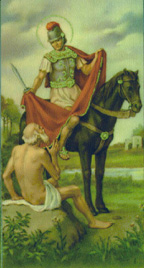
Saint Martin of Tours was born in in Savaria, Pannonia in either the year 316 or 336 AD. That region is what is today the nation of Hungary. His father was a tribune, which is a high-ranking officer in the Imperial Horse Guard. Martin and his family went with his father when he was assigned to a post at Ticinum, in Northern Italy. It is here that Martin would grow up.
Just before Martin was born, Christianity was legalized in the Roman Empire and the bloody persecution of Christians soon came to an end. It was not the official religion of the State, but it could be practiced and proclaimed openly. The Gospel message soon flourished in ancient Rome, transforming the empire. Martin's parents were pagans, but at the age of 10, Martin chose to respond to the call of the Gospel and become a Christian.
At the age of fifteen, Martin was required to follow his father into the cavalry corps of the Roman military. By the time he was 18, Martin is believed to have served in Gaul, and also eventually Milan and Treves. Scholars think he served as part of the emperor's guard.
As a young soldier, Martin encountered a beggar in Amiens. The beggar was unclothed and it was very cold. Martin removed his cloak and with his sword, he cut it in half. He gave this half to the beggar and dressed himself in the remnant. That night, Martin had a vision in which Christ appeared to him. The vision spoke to him, "Martin, a mere catechumen has clothed me." A catechumen is one who is being instructed in the Christian faith. In the early centuries of Christianity, that was a long process of instruction - and Martin was deeply dedicated to it.

Free RCIA classes for Students and Catechists from Catholic Online School
About the age of 20, Martin made clear to his superiors that he would no longer fight, following his formed Christian conscience. He refused his pay prior to a battle and announced he would not join in the combat. He became the first recognized conscientious objector in recorded history. His proclamation occurred before a battle near the modern German city of Worms. His superiors accused him of cowardice and ordered that he be imprisoned. Martin offered to demonstrate his sincerity by going into battle unarmed. This was seen as an acceptable alternative to jailing him, but before the battle could occur, the opposing army agreed to a truce and no conflict took place. Martin was subsequently released from military service.
Now out of the military service, Martin could fully dedicate himself to service of Jesus Christ and the Church. He traveled to Tours where he began studying under Hilary of Poitiers, who is now recognized as a doctor of the Church. Martin's studies lasted until Hilary was forced into temporary exile, likely because of his refusal to participate in a political dispute.
Martin then traveled to Italy. According to one account, Martin was confronted by a highwayman and led him to faith in Jesus Christ. Another account tells of Martin confronting the Devil. While on this journey, Martin had a vision which compelled him to return to his mother in Pannonia. He did so and led his own mother to faith in Jesus Christ. Martin attempted to persuade his father to embrace faith in Jesus Christ, but as far as we know, his father refused.
After bringing his mother to the Church, Martin then turned to confronting a growing heresy which was afflicting the faithful and sowing confusion. He became involved in countering the Arian heresy, which denied the divinity of Jesus Christ. The reaction against him was so violent from the Arian leaders that he was compelled to flee. Martin took up residence on an island in the Adriatic where he lived as a hermit for a time.
Martin's teacher Hilary returned to Tours from temporary exile in 361 so Martin traveled there to work and study. Hilary gave Martin a small grant of land where he and his disciples lived.
Martin established a monastery which would be inhabited by the Benedictines. Established in 361, the Liguge Abbey was destroyed during the French Revolution, then reestablished in 1853. The abbey remains to this day. From the site of his abbey, Martin worked to bring people to faith in Jesus Christ and Baptism into His Church in the surrounding areas. He was an extraordinary evangelist.


Free Catholic Knowledge Assessment from Catholic Online School
In 371, the city of Tours needed a new bishop and the people decided to call Martin to the office. Martin did not want the job so the people decided to trick him into the office. The people insisted he was needed to administer to someone sick, so he came out as quickly as he could. He did not even bother to improve his appearance. When he learned it was a trick to make him a bishop, Martin actually tried to hide. He was quickly discovered and the people called him forward to be ordained to the office of Bishop. Even though he did not really want the office, he was ordained - and he became a holy and hardworking Bishop.
As a Bishop Martin established a system of parishes to manage his diocese. He made a point to visit each parish at least once per year. In addition to his appointed rounds, Martin combated paganism, particularly the Druid religion which was still prevalent at the time. He passionately and faithfully proclaimed the Gospel of Jesus Christ and won many to the Christian faith.
Yet, he longed for more prayer and wanted to pursue a monastic life. In the year 372 Martin established an abbey at Marmoutier so he could retreat there and live as a monk with the many disciples he had attracted.
In the following years, a heresy broke out in the church. An aesthetic sect called the Priscillianists after their leader, Priscillian, had developed in Spain and Gaul. The First Council of Saragossa condemned the heresy, but the Priscillians did not change they practices. This prompted one bishop, Ithacius of Ossonoba to petition the Roman Emperor Magnus Maximus to put him to death. Martin was opposed to the sentence of death, and was joined by Bishop Ambrose of Milan in his opposition. Martin traveled to Trier where the Emperor held court. Martin was able to persuade the Emperor to refrain from putting Priscillian and his followers to death. However, after Martin left, Ithacius persuaded the Emperor to change his mind again and Priscillian and his followers were executed in 385.
Martin was so upset by Ithacius, he refused to communicate with his fellow bishop until the Emperor pressured him to resume communicating with his colleague.
Martin died in Candes-Saint-Martin, Gaul in 397.
The Hagiographer Sulpicius Severus, knew Martin personally and wrote about his life. Many miracles and the casting out of demons were attributed to Martin during his lifetime. According to one account, Martin, while trying to win Druids to follow Jesus Christ and renounce their pagan beliefs, was dared to stand in the path of a sacred tree that was being felled. Martin agreed and was missed by the falling pine, although standing right in its path. This was widely seen as miraculous and a symbol that the message he proclaimed about Jesus Christ was true. Many were converted to the Christian faith.
Veneration of St. Martin became popular in the Middle Ages, and was popular with the Frankish kings.
Saint Martin is the patron of the poor, soldiers, conscientious objectors, tailors, and winemakers. Many locations across Europe have also been placed under his patronage. His feast is on November 11. He commonly appears on horseback and is shown cutting his cloak in half with a sword.
- ← St. Martin Tinh
- St. Martius →
St. Martin of Tours Fun Facts

More Saints
- Trending Saints:
- St. Faustina Kowalska
- St. Francis of Assisi
- St. Michael the Archangel
- Bl. Laura Vicuna

Find Saints
- More Saints & Angels
Join the Movement When you sign up below, you don't just join an email list - you're joining an entire movement for Free world class Catholic education.

- Mysteries of the Rosary Mysteries of the Rosary
- St. Faustina Kowalska St. Faustina Kowalska
- Litany of the Blessed Virgin Mary Litany of the Blessed Virgin Mary
- Saint of the Day for Wednesday, Oct 4th, 2023 Saint of the Day for ...
- Popular Saints Popular Saints
- St. Francis of Assisi St. Francis of Assisi
- Bible Bible
- Female / Women Saints Female / Women Saints
- 7 Morning Prayers you need to get your day started with God 7 Morning Prayers you need to ...
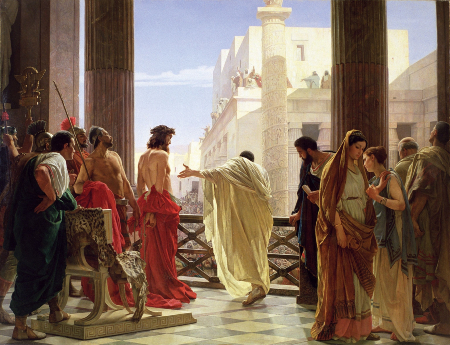
Letter from Bishop Strickland for April 4, 2024
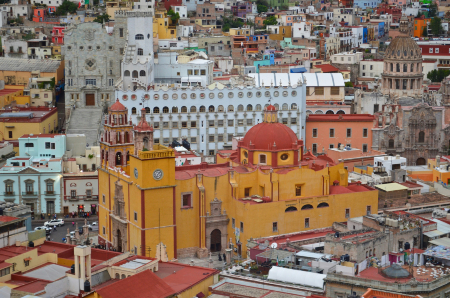
Mexican Bishops Mediate Truce Among Drug Traffickers
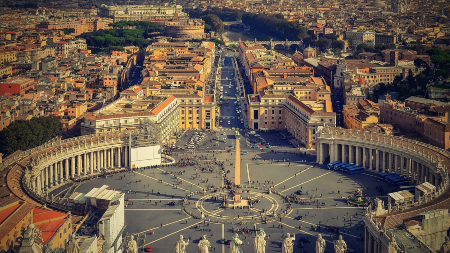
New Declaration on Human Dignity Coming Soon from the Vatican
Letter from archbishop vigano: on easter sunday, jesus weeps for our nation, happy easter: the tomb is empty love has triumphed, daily catholic.

- Daily Readings for Sunday, April 07, 2024
- St. John Baptist de la Salle: Saint of the Day for Sunday, April 07, 2024
- The Prayer "Thank You God": Prayer of the Day for Sunday, April 07, 2024
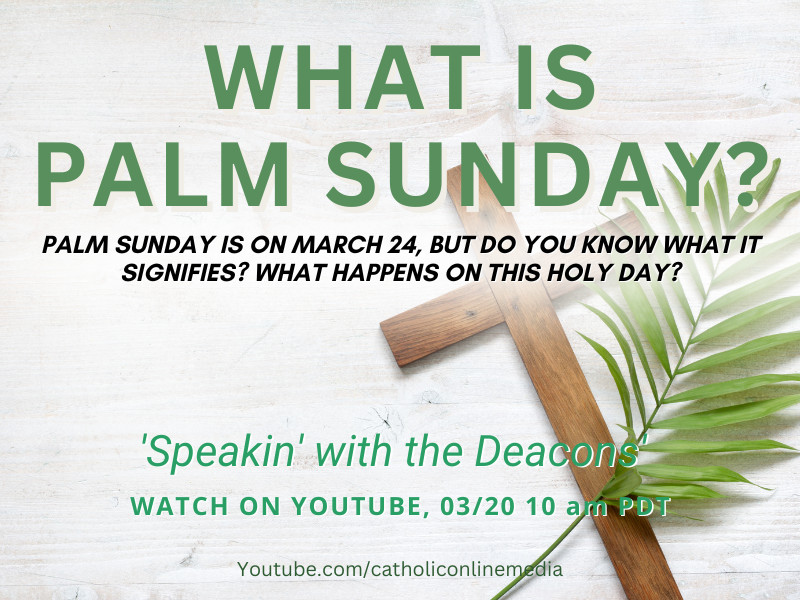
What is Palm Sunday?
Saints & angels.

- Saints Feast Days
- Female Saints
- Saint of the Day
- Browse Saints
- Popular Saints
- Patron Saints
- Saint Fun Facts
- Martyr Saints

- Mysteries of the Rosary
- Stations of the Cross
- Guide for Confession
- Prayer of the Day
- Browse Prayers
- Popular Prayers
- Holy Rosary
- Sacraments of the Catholic Church
- More Prayers
- Daily Readings
- New Testament
- Old Testament
- Books of the Bible
- Ten Commandments
More of Catholic Online
- Lent & Easter
- Advent & Christmas
- Catholic Encyclopedia
- All of Catholic Online
- Privacy Statement
- Terms of Service
Copyright 2024 Catholic Online. All materials contained on this site, whether written, audible or visual are the exclusive property of Catholic Online and are protected under U.S. and International copyright laws, © Copyright 2024 Catholic Online. Any unauthorized use, without prior written consent of Catholic Online is strictly forbidden and prohibited.
Catholic Online is a Project of Your Catholic Voice Foundation, a Not-for-Profit Corporation. Your Catholic Voice Foundation has been granted a recognition of tax exemption under Section 501(c)(3) of the Internal Revenue Code. Federal Tax Identification Number: 81-0596847. Your gift is tax-deductible as allowed by law.
We ask you, humbly: do not scroll away
To all our readers, please don't scroll past this..


- Catholicism
- Religious Catalogue
- Give Monthly
- 1-800-447-3986
- [email protected]
- See of Peter
- Daily Mass and Readings
- Seasons and Feast Days
- Traditional Latin Mass
- Prayer Requests
- EWTN News Nightly
- EWTN Pro-Life Weekly
- EWTN News In Depth
- The World Over
- National Catholic Register
- Catholic News Agency
- Weekly Schedule
- Channel Finder
- Listen Live
- Audio Archive
- Monthly Schedules
- Podcast Central
- Galaxy 33 Transmission Plan
- SW Frequency Guide
- SW Monitoring Form
- Frequently Asked Questions
- EWTN Religious Catalogue
- My Giving Account
- Ways to Give
- Mother Angelica
- Online Learning Series
- EWTN Everywhere
- Media Missionaries
- Privacy Policy
- International Satellite Feeds
St. Martin of Tours
St. Martin, called "the glory of Gaul," was born about the year 316 of pagan parents in Sabaria, Upper Pannonia, a province comprising northern Yugoslavia and western Hungary. His father was an officer in the Roman army who had risen from the ranks. While Martin was still a child, his father was transferred to a new station in Pavia, north Italy. Here the boy learned of Christianity, felt drawn to it, and became a catechumen. As the son of a veteran, at the age of fifteen he was required to begin service in the army. Though never shirking his military duty, he is said to have lived more like a monk than a soldier.
Young Martin was stationed at Amiens, in Gaul, when the incident occurred which tradition and art have rendered so famous. As he rode towards the town one winter day, he noticed near the gates a poor man, thinly clad, shivering with cold, and begging alms. Martin saw that none who passed stopped to help the miserable fellow. He had nothing with him but the clothes he wore, but, drawing his sword from its scabbard, he cut his great woolen cloak in two pieces, gave one half to the beggar, and wrapped himself in the other. The following night, the story continues, Martin in his sleep saw Jesus Christ, surrounded by angels, and dressed in the half of the cloak he had given away. A voice bade him look at it well and say whether he knew it. He then heard Jesus say to the angels, "Martin, as yet only a catechumen, has covered me with his cloak." Sulpicius Severus, the saint's friend and biographer, says that as a consequence of this vision Martin "flew to be baptized."
When Martin was about twenty, some Teutonic tribes invaded Gaul, and with his comrades he went before the Emperor Julian to receive a war-bounty. Suddenly he was moved to refuse it. "Up to now," he said to Julian, "I have served you as a soldier; allow me henceforth to serve Christ. Give the bounty to these others who are going out to battle. I am a soldier of Christ and it is not lawful for me to fight." Julian, angered, accused Martin of cowardice; the young man replied that he was ready to go into battle the next day unarmed, and advance alone against the enemy in the name of Christ. He was taken off to prison, but discharged as soon as a truce had been made. He then went down to Poitiers, where the renowned Hilary had been bishop for many years. Hilary gladly received this early "conscientious objector" and ordained him deacon.
Having heard in a dream a summons to revisit his home, Martin crossed the Alps, and from Milan went over to Pannonia. There he converted his mother and some other persons; his father he could not win. While in Illyricum he took sides against the Arians with so much zeal that he was publicly scourged and forced to leave. Back in Italy once more, on his way to Gaul, he learned that the Gallic Church was also under attack by the Arians, and that his good friend Hilary had been banished. He remained at Milan, but soon the Arian bishop, Auxentius, drove him away. Martin took refuge with a priest on the island of Gallinaria, in the gulf of Genoa, and stayed there until Hilary returned to Poitiers in 360. It had become Martin's desire to pursue his religious calling in solitude, and Hilary gave him a small piece of land in central France, now called Liguge. He was joined by other hermits and holy men, and the community grew into a monastery, the first, it is said, to be founded in Gaul. It survived until 1607; in 1852 it was rebuilt by the Benedictines of Solesmes.
For ten years Martin lived there, directing the life of his disciples and preaching in outlying places. Many miracles were attributed to him. About the year 371, Lidorius, bishop of Tours, died, and the people demanded Martin in his place. Martin was so reluctant to accept the office that they resorted to stratagem and called him to the city to give his blessing to a sick person, then forcibly conveyed him to the church. When neighboring bishops were summoned to confirm this choice, they thought the monk's poor and unkempt appearance proved him unfit for the office, but they were overruled by the acclamations of the local clergy and the people. Even as a bishop, Martin lived an austere life. Unable to endure the constant interruptions, he retired from Tours to a retreat that was later to become the famous abbey of Marmoutier. The site was enclosed by a steep cliff on one side and by a tributary of the Loire River on the other. Here Martin and some of the monks who followed him built cells of wood; others lived in caves dug out of the rock. In a short time their number grew, with many men of high rank among them. From this time on bishops were frequently chosen from Marmoutier, for the holy Martin took the greatest pains in the training of priests.
Martin's piety and preaching resulted in the decline of paganism in that part of Gaul. He destroyed temples and felled trees which the heathen held sacred. Once when he had demolished a certain temple, he proceeded to the cutting down of a pine tree that stood near. The chief priest and other pagans there offered to cut it down themselves, on condition that he who trusted so strongly in his God would stand under it wherever they would place him. The bishop agreed and allowed himself to be tied and placed on the side towards which the tree was leaning. Just as it seemed about to fall on him, he made the sign of the cross, at which the tree fell in the other direction. Another time, as he was pulling down a temple in the vicinity of Autun, a crowd of pagans fell on him in fury, one brandishing a sword. Martin stood and bared his breast, at sight of which the armed man fell backwards, and in terror begged forgiveness. These marvels are narrated by Sulpicius Severus, who also describes various revelations and visions with which Martin was favored.
Once a year the bishop visited each of his parishes, traveling on foot, or by donkey or boat. He continued to set up monastic communities, and extended the bounds of his episcopate from Touraine to such distant points as Chartres, Paris, Autun, and Vienne. At Vienne, according to his biographer, he cured Paulinus of Nola of a disease of the eyes. When a brutal imperial officer, Avitianus, arrived at Tours with a band of prisoners he planned to torture to death on the following day, Martin, on being informed of this, hurried in from Marmoutier to intercede for them. Reaching the city near midnight, he went straight to the quarters of Avitianus and did not leave until the officer promised mercy to his captives.
The churches of other parts of Gaul and in Spain were being disturbed by the Priscillianists, an ascetic sect, named for its leader, Priscillian, bishop of Avila. A synod held at Bordeaux in 384 had condemned his doctrines, but he had appealed to Emperor Maximus. Meanwhile, Ithacius, the orthodox bishop of Ossanova, had attacked him and urged the emperor to have him put to death. Neither Ambrose at Milan, however, nor Martin at Tours would hold communion with Ithacius or his supporters, because they had appealed to the emperor in a dispute over doctrine, and now were trying to punish a heretic with death. Martin wrote to reprove Ithacius severely. It was sufficient, he said, that Priscillian should be branded as a heretic and excommunicated by the bishops. Maximus, yielding to Martin's remonstrances, ordered the trial deferred and even promised that there should be no bloodshed, but afterwards he was persuaded to turn the case over to his prefect Evodius. He found Priscillian and some others guilty on several charges and had them beheaded. At this news, Martin went to Treves to intercede for the lives of all the Spanish Priscillianists who were threatened with a bloody persecution, and also for two men under suspicion as adherents of the late Emperor Gratian. As a condition before granting this request, Maximus stipulated that Martin should resume communion with the intolerant Ithacius and his party. Since they were not excommunicated, this was no violation of any canon, and he accordingly promised the emperor that he would do so, provided the emperor would pardon the two partisans of Gratian and recall the military tribunes he had sent to Spain. The next day Martin received the Sacrament with the Ithacians in order to save so many people from slaughter; yet he was afterwards troubled in conscience as to whether he had been too yielding. For their part in the affair both the emperor and Ithacius were censured by Pope Siricius. It was the first judicial death sentence for heresy, and it had the effect of spreading Priscillianism in Spain.
Martin had premonitions of his approaching death and predicted it to his disciples, who besought him not to leave them. "Lord," he prayed, "if Thy people still need me, I will not draw back from the work. Thy will be done." When his final sickness came upon him, he was at Candes, in a remote part of his diocese. The monks entreated him to allow them at least to put a sheet under him and make his last hours comfortable. "It becomes not a Christian," said Martin, "to die otherwise than upon ashes. I shall have sinned if I leave you any other example." He lay with eyes and hands raised to Heaven, until the brothers begged him to turn on one side to rest his body a little. "Allow me, my brethren," he answered, "to look towards Heaven rather than to earth, that my soul may be ready to take its flight to the Lord."
On November 8 he died, and three days later was buried at Tours. Two thousand monks and nuns gathered for his funeral. His successor built a chapel over his grave, which was replaced by a fine basilica. A still later church on this site was destroyed during the French Revolution, but a modern one has since been built there. Throughout the Middle Ages, the knightly Martin, who shared his cloak with a beggar, was the subject of innumerable anecdotes, which expressed the love and veneration of the people. His tomb became a national shrine in France, of which country he is patron saint, and one of the most popular pilgrimage places of Europe. St. Martin is patron of the cities of Wurtburg and Buenos Aires. Many churches in France and elsewhere have been dedicated to him. His emblems are a tree, armor, a cloak, and a beggar.

My Catholic Life!
A journey of personal conversion!

Saint Martin of Tours

November 11: Saint Martin of Tours, Bishop—Memorial
316 or 336–397 Patron Saint of beggars, cavalry, equestrians, geese, horses, innkeepers, Pontifical Swiss Guards, quartermasters, reformed alcoholics, soldiers, tailors, and winemakers Invoked against alcoholism and poverty Pre-Congregation canonization Liturgical Color: White
Accordingly, at a certain period, when he had nothing except his arms and his simple military dress, in the middle of winter, a winter which had shown itself more severe than ordinary, so that the extreme cold was proving fatal to many, he happened to meet at the gate of the city of Amiens a poor man destitute of clothing. He was entreating those that passed by to have compassion upon him, but all passed the wretched man without notice, when Martin, that man full of God, recognized that a being to whom others showed no pity, was, in that respect, left to him. Yet, what should he do? He had nothing except the cloak in which he was clad, for he had already parted with the rest of his garments for similar purposes. Taking, therefore, his sword with which he was girt, he divided his cloak into two equal parts, and gave one part to the poor man, while he again clothed himself with the remainder. ~From the Life of Saint Martin, by Sulpicius Severus
Saint Martin of Tours has been one of the most revered and loved saints in European history for two primary reasons: he lived a life of heroic sanctity, and someone wrote it all down. Sulpicius Severus is believed to have been a wealthy man who converted to Christianity through the ministry of Bishop Martin. He then became a priest, interviewed Bishop Martin before he died, and wrote a book about Martin’s incredible life. The book was copied over and over again and became one of the standard texts for religious and laity alike for many centuries. Numerous churches and monasteries bear Martin’s name as a result of his popularity.
Martin was born in Sabaria in Pannonia, within the Roman Empire, modern-day Szombathely, Hungary. Some early records state he was born in 316, others in 336. When Martin was young, his family moved to Ticinum, modern-day Pavia, northern Italy. He was born in the Roman Empire during an important period of change. In 313, Emperor Constantine issued the Edict of Milan, legalizing Christianity. Constantine then became a Christian himself, and it became known that he favored Christians over those who remained pagans. As a result, many people began converting, some for political and economic reasons.
Martin’s father was a soldier who advanced to the rank of military tribune. As a child, Martin became interested in Christianity, but his parents clung to Roman paganism, dismissing the newly legalized Christianity. Martin, however, was not satisfied with his parents’ choice. So, at the age of ten, he went to the local Catholic Church and asked to become a Christian. He was enrolled as a catechumen and began the lengthy process of preparing for Baptism, which would not take place until ten years later. When he was twelve years old, he asked his parents to permit him to become a hermit, but they refused. At the age of fifteen, in compliance with a state law requiring sons of military officers to enlist in the Roman military, Martin became a soldier. Despite being surrounded by many who lived immoral lives, Martin remained true to his faith and lived quite virtuously. His language was always respectful, he treated others with exceptional kindness, he often gave most of his money and belongings to the poor, he humbled himself by serving those who were supposed to serve him, and he continued his preparation for Baptism.
One day, while riding his horse through a town in the middle of winter, Martin came upon a poor man who was poorly dressed and shivering. The man begged people for help, but they ignored him. Martin knew he had to assist, but he had already given his money and other clothing away to the needy. All he had left was the military cloak he wore on his own back, so he dismounted his horse, took out his sword, cut the cloak in two, and gave half to the poor man. His fellow soldiers later laughed at his small funny-looking cloak. That night, Martin had a dream in which Jesus appeared to him wearing the half-cloak and said to a multitude of angels who surrounded them, “Martin, still only a catechumen, has clothed me.” When he awoke, he knew what he needed to do. He sought baptism, which he received at the age of twenty.
Martin remained in the military for two more years at the request of a friend. One day, the commanding officer was passing out bonuses to the soldiers as they prepared for battle the next day. When Martin was called forward, he stated, “I have been your soldier until now. Let me serve God henceforth. Give your bonus to someone who’ll fight for you. I am Christ’s soldier, and it’s not right for me to engage in battle.” Martin was accused of being a coward because they were going into battle the following day. To that accusation he replied, “If you believe I’m acting out of fear, I’ll stand unarmed in front of the enemy lines tomorrow. Shielded only by my faith in Jesus and the sign of the cross, I’ll face them without armor.” Martin was then thrown into prison to wait for the battle, which never happened because the opposing side sought peace. Martin was soon after released from the military.
Having heard of the renowned bishop and future Saint Hilary of Poitiers, Martin traveled to Poitiers in present-day France and stayed with the bishop for some time, learning from him the orthodox faith. He was also ordained a deacon and made an exorcist by Bishop Hilary. After Bishop Hilary was forced into exile for combating Arianism in the imperial court, and after Deacon Martin had a dream about converting his pagan parents, he decided to return to his hometown. On the way, he was attacked by robbers, but upon being asked who he was, he told one of the robbers that he was a Christian. Deacon Martin then shared the Gospel with the man, who repented, let Martin go, and later converted. When Deacon Martin arrived home, he converted his mother to the Christian faith but could not move his father. Others in his hometown also converted.
After encountering the wrath of some Arian priests whom he opposed, and even the Arian Archbishop of Milan, Deacon Martin and a priest spent time living as hermits on the Island of Gallinara. There they lived on herbs and wild roots. One day Martin ate a poisonous root by mistake, but through fervent prayer, God healed him.
Upon hearing that Bishop Hilary’s exile from Poitiers had ended, Deacon Martin moved to a town near the holy bishop and established a monastery. From there, he began preaching throughout the region and performing many miracles. He restored an unbaptized catechumen to life. When the catechumen returned to life, he stated that it was due to Martin’s prayers. On another occasion, Martin brought a slave back to life who had hung himself.
In 371, Martin was chosen by the consent of the people as the Bishop of Tours. Though he initially opposed it and tried to hide, he was tricked and led to the cathedral where his ordination awaited. Once ordained the Bishop of Tours, Bishop Martin moved outside the city and established hermitages with other clerics where he led a life of prayer. For the next twenty-six years, he lived both an eremitical life and also engaged in an active ministry. He traveled throughout Gaul (France), preaching, converting many, performing miracles, and casting out demons. He opposed heresies, worked with other orthodox bishops—such as the future Saint Ambrose of Milan—destroyed pagan temples, and gained the respect of all. His opponents feared him, and his supporters praised God every time they witnessed his ministry in action.
Though Saint Martin of Tours lived a life of heroic virtue and deep prayer, his life and veneration reveal the importance of sharing the stories of the saints with others. After his death, his life has continued to inspire many. As we honor Saint Martin, ponder any ways that God might want to use you as He used Sulpicius Severus, Saint Martin’s biographer. Though you might not be called to write a book about a saint you know, consider ways in which you can share the Gospel by learning more about the saints and sharing their stories with others.
Saint Martin of Tours, though you were born into a pagan family, God spoke to your heart from an early age, and you listened and responded. Your kindness, deep prayer, and generosity led to your ongoing conversion, making you an inspiration to all. Please pray for me, that I will always listen to God’s voice and respond with all my heart. Saint Martin of Tours, pray for me. Jesus, I trust in You.
Further Reading:
Pope Benedict XVI
Catholic Encyclopedia
Butler’s Lives of the Saints
Catholic Fire
Catholic News Agency
Franciscan Media
All Saints for Today
All Saints for the Liturgical Year
January February March Holy Week & Easter April May Feasts at the Conclusion of the Easter Season June July August September October November December
Additional calendars from around the world>>>
Saints A–Z>>>
Home / The Orthodox Faith / Lives of the Saints /
Saint Martin the Merciful, Bishop of Tours
Troparion & Kontakion
Saints and Feasts
Martin, bishop of tours.

November 12
Saint Martin, the great luminary of Gaul, was the son of pagan parents. When he was still quite young he became a catechumen; at the age of twenty-two he received Holy Baptism. Then he undertook the labours of a monk, and was afterwards consecrated Bishop of Tours, renowned as an ascetic and wonderworker, a faithful shepherd of Christ's flock. He converted many both from paganism and heresy, cast out demons and raised the dead, and while undertaking all the apostolic burdens of a bishop, he never ceased to be a simple monk and man of prayer. His monastery became a center of monasticism not only for Gaul, but for all of Western Europe. A widely celebrated incident of his life took place when he was still a catechumen, fulfilling his military service. Seeing an ill-clad beggar asking alms at the gate of the city of Amiens and being overlooked by passersby, Saint Martin, having nothing else to give, rent his military cloak in two with his sword and gave half to the beggar, so that he might cover himself in the cold. That night, the Lord Jesus Christ appeared to him, clothed with the half of the cloak he had given to the beggar. Saint Martin's cloak - capella in Latin - was kept in a sanctuary which came to be called capella , from which the word "chapel" is derived; and they under whose care it was kept were called cappellani , from which "chaplain" is derived. Saint Martin reposed in peace in the year 397.
Apolytikion of Martin, Bishop of Tours
Fourth tone.
In signs and in miracles thou wast renowned throughout Gaul; by grace and adoption now thou art a light for the world, O Martin, most blest of God. Almsdeeds and compassion filled thy life with their splendour; teaching and wise counsel were thy riches and treasures, which thou dost dispense freely unto all them that honour thee.
Kontakion of Martin, Bishop of Tours
Plagal of the fourth tone.
As a devoted man of God, thou didst proclaim His mysteries. And as a seer of the Trinity, thou didst shed thy blessings on the Occident. By thy prayers and entreaties, O adornment of Tours and glory of all the Church, preserve us, O Saint Martin, and save all who praise thy memory.
Blessed Feast Day
Share the feast of Martin, Bishop of Tours with an icon greeting ecard.

The Episcopal Church
Welcomes You
The Lectionary Calendar
This page is available in: Español
Martin of Tours, Bishop, 397
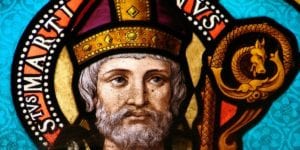
The Collect:
Rite I: Lord God of hosts, who didst clothe thy servant Martin the soldier with the spirit of sacrifice and set him as a bishop in thy church to be a defender of the catholic faith: Give us grace to follow in his holy steps, that, at the last, we may be found clothed with righteousness in the dwellings of peace; through Jesus Christ our Lord, who liveth and reigneth with thee and the Holy Ghost, one God, for ever and ever. Amen.
Rite II: Lord God of hosts, you clothed your servant Martin the soldier with the spirit of sacrifice and set him as a bishop in your church to be a defender of the catholic faith: Give us grace to follow in his holy steps, that, at the last, we may be found clothed with righteousness in the dwellings of peace; through Jesus Christ our Lord, who lives and reigns with you and the Holy Spirit, one God, for ever and ever. Amen.
First Lesson: Isaiah 58:6-12
6 Is not this the fast that I choose: to loose the bonds of injustice, to undo the thongs of the yoke, to let the oppressed go free, and to break every yoke? 7 Is it not to share your bread with the hungry, and bring the homeless poor into your house; when you see the naked, to cover them, and not to hide yourself from your own kin? 8 Then your light shall break forth like the dawn, and your healing shall spring up quickly; your vindicator shall go before you, the glory of the Lord shall be your rearguard. 9 Then you shall call, and the Lord will answer; you shall cry for help, and he will say, Here I am. If you remove the yoke from among you, the pointing of the finger, the speaking of evil, 10 if you offer your food to the hungry and satisfy the needs of the afflicted, then your light shall rise in the darkness and your gloom be like the noonday. 11 The Lord will guide you continually, and satisfy your needs in parched places, and make your bones strong; and you shall be like a watered garden, like a spring of water, whose waters never fail. 12 Your ancient ruins shall be rebuilt; you shall raise up the foundations of many generations; you shall be called the repairer of the breach, the restorer of streets to live in.
Psalm: Psalm 15
1 Lord, who may dwell in your tabernacle? * who may abide upon your holy hill? 2 Whoever leads a blameless life and does what is right, * who speaks the truth from his heart. 3 There is no guile upon his tongue; he does no evil to his friend; * he does not heap contempt upon his neighbor. 4 In his sight the wicked is rejected, * but he honors those who fear the Lord. 5 He has sworn to do no wrong * and does not take back his word. 6 He does not give his money in hope of gain, * nor does he take a bribe against the innocent. 7 Whoever does these things * shall never be overthrown.
Gospel: Matthew 25:31–40
31 ‘When the Son of Man comes in his glory, and all the angels with him, then he will sit on the throne of his glory. 32 All the nations will be gathered before him, and he will separate people one from another as a shepherd separates the sheep from the goats, 33 and he will put the sheep at his right hand and the goats at the left. 34 Then the king will say to those at his right hand, “Come, you that are blessed by my Father, inherit the kingdom prepared for you from the foundation of the world; 35 for I was hungry and you gave me food, I was thirsty and you gave me something to drink, I was a stranger and you welcomed me, 36 I was naked and you gave me clothing, I was sick and you took care of me, I was in prison and you visited me.” 37 Then the righteous will answer him, “Lord, when was it that we saw you hungry and gave you food, or thirsty and gave you something to drink? 38 And when was it that we saw you a stranger and welcomed you, or naked and gave you clothing? 39 And when was it that we saw you sick or in prison and visited you?” 40 And the king will answer them, “Truly I tell you, just as you did it to one of the least of these who are members of my family, you did it to me.”
Lectionary Calendar
The Old Testament, New Testament and Gospels readings are from the New Revised Standard Version Bible, copyright © 1989 National Council of the Churches of Christ in the United States of America. Used by permission. All rights reserved worldwide.
The Collects, Psalms, and Canticles are from the Book of Common Prayer, 1979.
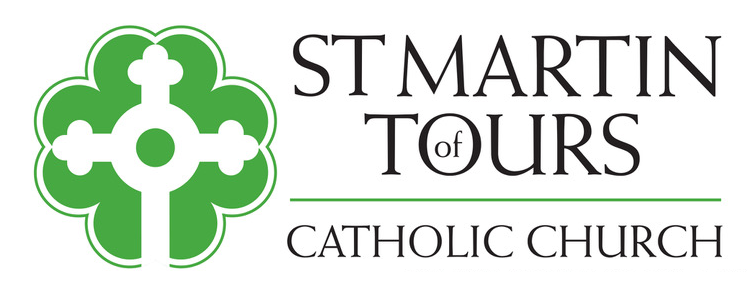
- Faith Formation
- Altar Society
- Community Service
- Knights of Columbus
- More…
- My Own Church
- Online Giving
- Recorded Masses
St. Martin of Tours Catholic Church | Martinsville, Indiana
Very Rev.Stephen Giannini Learn more about Fr. Steve
https://www.archindy.org/staff/priests/giannini-stephen.html
ASSISTING PRIESTS We are honored and grateful to have staff from Bishop Simon Brute’ College Seminary serve our parish by offering weekend and Holy Day masses, giving Fr. Steve the help and support he needs as he serves both our parish and the parish of Saints Francis and Clare of Assisi in Greenwood. +Very Rev. Joseph Moriarty – Rector at Bishop Simon Brute’ +Rev. Andrew Syberg – Vice Rector at Bishop Simon Brute’
Our Patron Saint
Saint Martin of Tours, born around 316 AD at Sabaria, Pannonia [now Szombathely, Hungary], became the third Bishop of Tours and is highly esteemed as a great saint by the Church of France. Actually, many locations across Europe have also been placed under his patronage. St. Martin is the patron of the poor, soldiers, conscientious objectors, tailors, and winemakers. A great number of miracles have been recorded due to his intercession while living and after his death. We celebrate his feast day November 11th and encourage you to learn more about Saint Martin of Tours.
Parish History
The first church building was erected under the direction of Rev. Daniel Maloney, who from 1848–1855 served the small local group of Catholics in Martinsville from his home parish in Columbus, IN.
St. Martin of Tours
Please help support the mission of New Advent and get the full contents of this website as an instant download. Includes the Catholic Encyclopedia, Church Fathers, Summa, Bible and more — all for only $19.99...
Bishop; born at Sabaria (today Steinamanger in German, or Szombathely in Hungarian), Pannonia (Hungary), about 316; died at Candes, Touraine, most probably in 397. In his early years, when his father , a military tribune, was transferred to Pavia in Italy , Martin accompanied him thither, and when he reached adolescence was, in accordance with the recruiting laws enrolled in the Roman army. Touched by grace at an early age, he was from the first attracted towards Christianity , which had been in favour in the camps since the conversion of Emperor Constantine . His regiment was soon sent to Amiens in Gaul , and this town became the scene of the celebrated legend of the cloak. At the gates of the city, one very cold day, Martin met a shivering and half-naked beggar. Moved with compassion, he divided his coat into two parts and gave one to the poor man. The part kept by himself became the famous relic preserved in the oratory of the Frankish kings under the name of "St. Martin's cloak". Martin, who was still only a catechumen , soon received baptism , and was a little later finally freed from military service at Worms on the Rhine. As soon as he was free, he hastened to set out to Poitiers to enrol himself among the disciples of St. Hilary, the wise and pious bishop whose reputation as a theologian was already passing beyond the frontiers of Gaul. Desiring, however, to see his parents again, he returned to Lombardy across the Alps. The inhabitants of this region, infested with Arianism , were bitterly hostile towards Catholicism , so that Martin, who did not conceal his faith , was very badly treated by order of Bishop Auxentius of Milan , the leader of the heretical sect in Italy . Martin was very desirous of returning to Gaul , but, learning that the Arians troubled that country also and had even succeeded in exiling Hilary to the Orient, he decided to seek shelter on the island of Gallinaria (now Isola d'Albenga) in the middle of the Tyrrhenian Sea.
As soon as Martin learned that an imperial decree had authorized Hilary to return to Gaul , he hastened to the side of his chosen master at Poitiers in 361, and obtained permission from him to embrace at some distance from there in a deserted region (now called Ligugé) the solitary life that he had adopted in Gallinaria. His example was soon followed, and a great number of monks gathered around him. Thus was formed in this Gallic Thebaid a real laura, from which later developed the celebrated Benedictine Abbey of Ligugé. Martin remained about ten years in this solitude, but often left it to preach the Gospel in the central and western parts of Gaul, where the rural inhabitants were still plunged in the darkness of idolatry and given up to all sorts of gross superstitions . The memory of these apostolic journeyings survives to our day in the numerous local legends of which Martin is the hero and which indicate roughly the routes that he followed. When St. Lidorius, second Bishop of Tours , died in 371 or 372, the clergy of that city desired to replace him by the famous hermit of Ligugé. But, as Martin remained deaf to the prayers of the deputies who brought him this message, it was necessary to resort to a ruse to overcome his resistance. A certain Rusticius, a rich citizen of Tours , went and begged him to come to his wife, who was in the last extremity, and to prepare her for death. Without any suspicions, Martin followed him in all haste, but hardly had he entered the city when, in spite of the opposition of a few ecclesiastical dignitaries, popular acclamation constrained him to become Bishop of the Church of Tours .
Consecrated on 4 July, Martin brought to the accomplishment of the duties of his new ministry all the energy and the activity of which he had already given so many proofs . He did not, however, change his way of life: fleeing from the distractions of the large city, he settled himself in a small cell at a short distance from Tours , beyond the Loire. Some other hermits joined him there, and thus was gradually formed a new monastery , which surpassed that of Ligugé, as is indicated by the name, Marmoutier ( Majus Monasterium ), which it has kept to our own day. Thus, to an untiring zeal Martin added the greatest simplicity, and it is this which explains how his pastoral administration so admirably succeeded in sowing Christianity throughout Touraine. Nor was it a rare occurrence for him to leave his diocese when he thought that his appearance in some distant locality might produce some good. He even went several times to Trier , where the emperors had established their residence, to plead the interests of the Church or to ask pardon for some condemned person . His role in the matter of the Priscillianists and Ithacians was especially remarkable. Against Priscillian, the Spanish heresiarch, and his partisans, who had been justly condemned by the Council of Saragossa, furious charges were brought before Emperor Maximus by some orthodox bishops of Spain , led by Bishop Ithacius. Martin hurried to Trier , not indeed to defend the Gnostic and Manichaean doctrines of Priscillian, but to remove him from the secular jurisdiction of the emperor. Maximus at first acceded to his entreaty, but, when Martin had departed, yielded to the solicitations of Ithacius and ordered Priscillian and his followers to be beheaded. Deeply grieved, Martin refused to communicate with Ithacius. However, when he went again to Trier a little later to ask pardon for two rebels, Narses and Leucadius, Maximus would only promise it to him on condition that he would make his peace with Ithaeius. To save the lives of his clients, he consented to this reconciliation, but afterwards reproached himself bitterly for this act of weakness.
After a last visit to Rome , Martin went to Candes, one of the religious centres created by him in his diocese , when he was attacked by the malady which ended his life. Ordering himself to be carried into the presbytery of the church, he died there in 400 (according to some authorities, more probably in 397) at the age of about 81, evincing until the last that exemplary spirit of humility and mortification which he had ever shown. The Church of France has always considered Martin one of her greatest saints , and hagiographers have recorded a great number of miracles due to his intercession while he was living and after his death. His cult was very popular throughout the Middle Ages , a multitude of churches and chapels were dedicated to him, and a great number of places have been called by his name. His body, taken to Tours , was enclosed in a stone sarcophagus, above which his successors, St. Britius and St. Perpetuus , built first a simple chapel , and later a basilica (470). St. Euphronius, Bishop of Autun and a friend of St. Perpetuus , sent a sculptured tablet of marble to cover the tomb . A larger basilica was constructed in 1014 which was burned down in 1230 to be rebuilt soon on a still larger scale This sanctuary was the centre of great national pilgrimages until 1562, the fatal year when the Protestants sacked it from top to bottom, destroying the sepulchre and the relics of the great wonder-worker, the object of their hatred . The ill-fated collegiate church was restored by its canons, but a new and more terrible misfortune awaited it. The revolutionary hammer of 1793 was to subject it to a last devastation. It was entirely demolished with the exception of the two towers which are still standing and, so that its reconstruction might be impossible, the atheistic municipality caused two streets to be opened up on its site. In December, 1860, skilfully executed excavations located the site of St. Martin's tomb , of which some fragments were discovered. These precious remains are at present sheltered in a basilica built by Mgr Meignan, Archbishop of Tours which is unfortunately of very small dimensions and recalls only faintly the ancient and magnificent cloister of St. Martin. On 11 November each year the feast of St. Martin is solemnly celebrated in this church in the presence of a large number of the faithful of Tours and other cities and villages of the diocese .
About this page
APA citation. Clugnet, L. (1910). St. Martin of Tours. In The Catholic Encyclopedia. New York: Robert Appleton Company. http://www.newadvent.org/cathen/09732b.htm
MLA citation. Clugnet, Léon. "St. Martin of Tours." The Catholic Encyclopedia. Vol. 9. New York: Robert Appleton Company, 1910. <http://www.newadvent.org/cathen/09732b.htm>.
Transcription. This article was transcribed for New Advent by Michael C. Tinkler. In honor of the Societas Sancti Martini Episcopi Turonensis at Emory University.
Ecclesiastical approbation. Nihil Obstat. October 1, 1910. Remy Lafort, Censor. Imprimatur. +John M. Farley, Archbishop of New York.
Contact information. The editor of New Advent is Kevin Knight. My email address is webmaster at newadvent.org. Regrettably, I can't reply to every letter, but I greatly appreciate your feedback — especially notifications about typographical errors and inappropriate ads.
CONTACT US | ADVERTISE WITH NEW ADVENT

IMAGES
COMMENTS
Martin of Tours (Latin: Martinus Turonensis; 316/336 - 8 November 397), also known as Martin the Merciful, was the third bishop of Tours. He has become one of the most familiar and recognizable Christian saints in France, heralded as the patron saint of the Third Republic, and is patron saint of many communities and organizations across Europe.A native of Pannonia (in present-day Hungary ...
St. Martin of Tours (born 316, Sabaria, Pannonia [now Szombathely, Hungary]—died November 8, 397, Candes, Gaul [France]; Western feast day, November 11; Eastern feast day November 12) was the patron saint of France, father of monasticism in Gaul, and the first great leader of Western monasticism. Of pagan parentage, Martin chose Christianity ...
Saint Martin of Tours is a Patron Saint of: Horses. Soldiers. South Africa. Saint Martin of Tours is often depicted as a soldier mounted on a horse sharing his cloak with a poor man. He became a monk and then a bishop, but he never lost his love for the poor. He spent a good deal of energy fighting for the Church, and for mercy toward heretics.
Saint Gregory of Tours, bishop and writer whose Ten Books of Histories is the major 6th-century source for studying the Merovingian kingdom of the Franks. His writings demonstrate his concern with church legislation, and he was known for his promotion of the cults of numerous saints.
Saint Martin of Tours (c. 316, Savaria, Pannonia - November 8, 397, Candes, Gaul) was a bishop of Tours who has become one of the most famous and recognizable Roman Catholic saints.. As a soldier in the Roman army, Martin shared his cloak with a freezing beggar and received a vision of Christ which moved him to renounce military life and become a monk.
When St. Lidorius, second Bishop of Tours, died in 371 or 372, the clergy of that city desired to replace him by the famous hermit of Liguge. But, as Martin remained deaf to the prayers of the deputies who brought him this message, it was necessary to resort to a ruse to overcome his resistance. ... The Church of France has always considered ...
Gregory of Tours (born Georgius Florentius; 30 November c. 538 - 17 November 594 AD) was a Gallo-Roman historian and Bishop of Tours during the Merovingian period and is known as the "father of French history." He was a prelate in the Merovingian kingdom, encompassing Gaul's historic region.. Gregory's most notable work is the Decem Libri Historiarum (Ten Books of Histories), also known as ...
St. Martin of Tours. On Nov. 11, the Catholic Church honors St. Martin of Tours, who left his post in the Roman army to become a "soldier of Christ" as a monk and later bishop. Martin was born ...
St. Martin of Tours. Both Saint Martin and Saint Nicholas are remembered for their heroic charity, both became famed wonder-working bishops, and both saved sailors from shipwreck. As we celebrate the feast day of Martin, November 11, we focus here on this saint whose fabled life notably started with the pity he showed a poor beggar by cutting ...
The Basilica of St. Martin of Tours is located close to the old city center of Tours, approximately 120 miles southwest of Paris. It's geographic proximity to and historic connection with Poitiers makes it a perfect combination visit with the Tomb of Hilary of Poitiers. The basilica is open daily from 7:30am-7:00pm. There is no cost of admission.
The cathedral at Tours was built by St. Martin in honour of St. Maurice; but since the year 1096 bears the title of St. Gatian's. Its chapter is one of the most illustrious in France; the Bishop of Tours was suffragan to Rouen till he was made a metropolitan. A vial of sacred oil is kept at St. Martin's, with which Henry IV was anointed king ...
Death: 397. Author and Publisher - Catholic Online. Printable Catholic Saints PDFs. Shop St. Martin of Tours. Saint Martin of Tours was born in in Savaria, Pannonia in either the year 316 or 336 AD. That region is what is today the nation of Hungary. His father was a tribune, which is a high-ranking officer in the Imperial Horse Guard.
November 2, 2023. On November 11, the Catholic Church honors St. Martin of Tours, who left his post in the Roman army to become a "soldier of Christ" as a monk and later bishop. Martin was born around the year 316 in modern-day Hungary. His family left that region for Italy when his father, a military official of the Roman Empire, had to ...
St. Martin of Tours. St. Martin, called "the glory of Gaul," was born about the year 316 of pagan parents in Sabaria, Upper Pannonia, a province comprising northern Yugoslavia and western Hungary. His father was an officer in the Roman army who had risen from the ranks. While Martin was still a child, his father was transferred to a new station ...
November 11: Saint Martin of Tours, Bishop—Memorial. 316 or 336-397 Patron Saint of beggars, cavalry, equestrians, geese, horses, innkeepers, Pontifical Swiss Guards, quartermasters, reformed alcoholics, soldiers, tailors, and winemakers Invoked against alcoholism and poverty Pre-Congregation canonization Liturgical Color: White
The Archdiocese of Tours (Latin: Archidioecesis Turonensis; French: Archidiocèse de Tours) is a Latin Church archdiocese of the Catholic Church in France.The archdiocese has roots that go back to the 3rd century, while the formal erection of the diocese dates from the 5th century. The ecclesiastical province of Tours corresponds with the late Roman province of Tertia Lugdunensis.
Commemorated on October 12. Troparion & Kontakion. Saint Martin the Merciful, Bishop of Tours, was born at Sabaria in Pannonia (modern Hungary) in 316. Since his father was a Roman officer, he also was obliged to serve in the army. Martin did so unwillingly, for he considered himself a soldier of Christ, though he was still a catechumen.
From 573 until his death in 594, Georgius Florentius Gregorius served as bishop of Tours. Today, Gregory is best known as a writer: although interest in his hagiographic writings has burgeoned in recent years, he is still remembered primarily as the author of the ten books of Histories.1 The first three and a half books of the Histories offer an account of events from creation up to Gregory ...
Kontakion of Martin, Bishop of Tours Plagal of the Fourth Tone. As a devoted man of God, thou didst proclaim His mysteries. And as a seer of the Trinity, thou didst shed thy blessings on the Occident. By thy prayers and entreaties, O adornment of Tours and glory of all the Church, preserve us, O Saint Martin, and save all who praise thy memory.
Martin of Tours, Bishop, 397. The Collect: Rite I: Lord God of hosts, who didst clothe thy servant Martin the soldier with the spirit of sacrifice and set him as a bishop in thy church to be a defender of the catholic faith: Give us grace to follow in his holy steps, that, at the last, we may be found clothed with righteousness in the dwellings of peace; through Jesus Christ our Lord, who ...
Our Patron Saint. Saint Martin of Tours, born around 316 AD at Sabaria, Pannonia [now Szombathely, Hungary], became the third Bishop of Tours and is highly esteemed as a great saint by the Church of France. Actually, many locations across Europe have also been placed under his patronage. St. Martin is the patron of the poor, soldiers ...
When St. Lidorius, second Bishop of Tours, died in 371 or 372, the clergy of that city desired to replace him by the famous hermit of Ligugé. But, as Martin remained deaf to the prayers of the deputies who brought him this message, it was necessary to resort to a ruse to overcome his resistance. A certain Rusticius, a rich citizen of Tours ...
St Martin was born sometime around 315 AD at Sabaria in Pannonia (now the city of Szombathley in modern Hungary). After leaving the army he spent time as a recluse on an island off the Ligurian Coast before founding a religious order at Liguge. An active missionary he became Bishop of Tours in 370. He died in 397 at Candes near Tours.
Home Free Global Crusade 15 - Christ: The Peacemaker Tour (Batangas), featuring the message of Global Evangelist Bishop Jonathan S. Ferriol | April 07, 2024